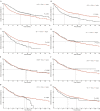Persistent increase and improved survival of stage I lung cancer based on a large-scale real-world sample of 26,226 cases
- PMID: 37394562
- PMCID: PMC10431578
- DOI: 10.1097/CM9.0000000000002729
Persistent increase and improved survival of stage I lung cancer based on a large-scale real-world sample of 26,226 cases
Abstract
Background: Lung cancer prevails and induces high mortality around the world. This study provided real-world information on the evolution of clinicopathological profiles and survival outcomes of lung cancer, and provided survival information within stage I subtypes.
Methods: Patients pathologically confirmed with lung cancer between January 2009 and December 2018 were identified with complete clinicopathological information, molecular testing results, and follow-up data. Shifts in clinical characteristics were evaluated using χ2 tests. Overall survival (OS) was calculated through the Kaplan-Meier method.
Results: A total of 26,226 eligible lung cancer patients were included, among whom 62.55% were male and 52.89% were smokers. Non-smokers and elderly patients took increasingly larger proportions in the whole patient population. The proportion of adenocarcinoma increased from 51.63% to 71.80%, while that of squamous carcinoma decreased from 28.43% to 17.60%. Gene mutations including EGFR (52.14%), KRAS (12.14%), and ALK (8.12%) were observed. Female, younger, non-smoking, adenocarcinoma patients and those with mutated EGFR had better survival prognoses. Importantly, this study validated that early detection of early-stage lung cancer patients had contributed to pronounced survival benefits during the decade. Patients with stage I lung cancer, accounted for an increasingly considerable proportion, increasing from 15.28% to 40.25%, coinciding with the surgery rate increasing from 38.14% to 54.25%. Overall, period survival analyses found that 42.69% of patients survived 5 years, and stage I patients had a 5-year OS of 84.20%. Compared with that in 2009-2013, the prognosis of stage I patients in 2014-2018 was dramatically better, with 5-year OS increasing from 73.26% to 87.68%. Regarding the specific survival benefits among stage I patients, the 5-year survival rates were 95.28%, 93.25%, 82.08%, and 74.50% for stage IA1, IA2, IA3, and IB, respectively, far more promising than previous reports.
Conclusions: Crucial clinical and pathological changes have been observed in the past decade. Notably, the increased incidence of stage I lung cancer coincided with an improved prognosis, indicating actual benefits of early detection and management of lung cancer.
Copyright © 2023 The Chinese Medical Association, produced by Wolters Kluwer, Inc. under the CC-BY-NC-ND license.
Conflict of interest statement
None.
Figures





Similar articles
-
Effect of epidermal growth factor receptor mutation on early-stage non-small cell lung cancer according to the 8th TNM classification.Lung Cancer. 2020 Jul;145:111-118. doi: 10.1016/j.lungcan.2020.04.012. Epub 2020 May 11. Lung Cancer. 2020. PMID: 32428800
-
[Relationship between EGFR and KRAS mutations and prognosis in Chinese patients with non-small cell lung cancer: a mutation analysis with real-time polymerase chain reaction using scorpion amplification refractory mutation system].Zhonghua Bing Li Xue Za Zhi. 2012 Oct;41(10):652-6. doi: 10.3760/cma.j.issn.0529-5807.2012.10.002. Zhonghua Bing Li Xue Za Zhi. 2012. PMID: 23302304 Chinese.
-
Differences in the survival of patients with recurrent versus de novo metastatic KRAS-mutant and EGFR-mutant lung adenocarcinomas.Cancer. 2015 Jun 15;121(12):2078-82. doi: 10.1002/cncr.29313. Epub 2015 Mar 17. Cancer. 2015. PMID: 25781862 Free PMC article.
-
[Current status of postoperative pathological diagnosis of lung cancer in China: a multicenter big data study].Zhonghua Bing Li Xue Za Zhi. 2021 Aug 8;50(8):882-890. doi: 10.3760/cma.j.cn112151-20210427-00328. Zhonghua Bing Li Xue Za Zhi. 2021. PMID: 34344071 Chinese.
-
Prognostic Analysis of Pathological Stage I Lung Adenocarcinoma Harboring Major EGFR Mutations.Clin Lung Cancer. 2025 May;26(3):e172-e180.e5. doi: 10.1016/j.cllc.2024.12.011. Epub 2024 Dec 26. Clin Lung Cancer. 2025. PMID: 39824660
Cited by
-
A Holistic Approach to Implementing Artificial Intelligence in Lung Cancer.Indian J Surg Oncol. 2025 Feb;16(1):257-278. doi: 10.1007/s13193-024-02079-6. Epub 2024 Sep 5. Indian J Surg Oncol. 2025. PMID: 40114896 Review.
-
China Protocol for early screening, precise diagnosis, and individualized treatment of lung cancer.Signal Transduct Target Ther. 2025 May 27;10(1):175. doi: 10.1038/s41392-025-02256-1. Signal Transduct Target Ther. 2025. PMID: 40425545 Free PMC article. Review.
-
Establishment and verification of novel TNM staging system for lung mucinous adenocarcinoma.BMC Cancer. 2024 Jul 31;24(1):925. doi: 10.1186/s12885-024-12714-8. BMC Cancer. 2024. PMID: 39085796 Free PMC article.
-
The prognostic value of visceral pleural infiltration in ≤3 cm nonsmall cell lung cancer presenting with ground glass opacity: an inverse probability of treatment weighting study.Int J Surg. 2024 Dec 1;110(12):7871-7879. doi: 10.1097/JS9.0000000000001803. Int J Surg. 2024. PMID: 38913435 Free PMC article.
-
Role of silent mutations in KRAS -mutant tumors.Chin Med J (Engl). 2025 Feb 5;138(3):278-288. doi: 10.1097/CM9.0000000000003405. Epub 2024 Dec 10. Chin Med J (Engl). 2025. PMID: 39654099 Free PMC article. Review.
References
-
- Sung H Ferlay J Siegel RL, et al. . Global Cancer Statistics 2020: GLOBOCAN Estimates of Incidence and Mortality Worldwide for 36 Cancers in 185 Countries. CA Cancer J Clin 2021;71: 209–249. doi: 10.3322/caac.21660 - PubMed
-
- Shi JF Wang L Wu N Li JL Hui ZG Liu SM, et al. . Clinical characteristics and medical service utilization of lung cancer in China, 2005-2014: Overall design and results from a multicenter retrospective epidemiologic survey. Lung Cancer 2019;128: 91–100. doi: 10.1016/j.lungcan.2018.11.031. - PubMed
-
- Allemani C Matsuda T Di Carlo V Harewood R Matz M Nikšić M, et al. . Global surveillance of trends in cancer survival 2000-14 (CONCORD-3): analysis of individual records for 37 513 025 patients diagnosed with one of 18 cancers from 322 population-based registries in 71 countries. Lancet 2018;391: 1023–1075. doi: 10.1016/s0140-6736(17)33326-3. - PMC - PubMed
-
- Zeng H Chen W Zheng R Zhang S Ji JS Zou X, et al. . Changing cancer survival in China during 2003-15: a pooled analysis of 17 population-based cancer registries. Lancet Glob Health 2018;6: e555–e567. doi: 10.1016/s2214-109x(18)30127-x. - PubMed
MeSH terms
Substances
LinkOut - more resources
Full Text Sources
Medical
Research Materials
Miscellaneous

